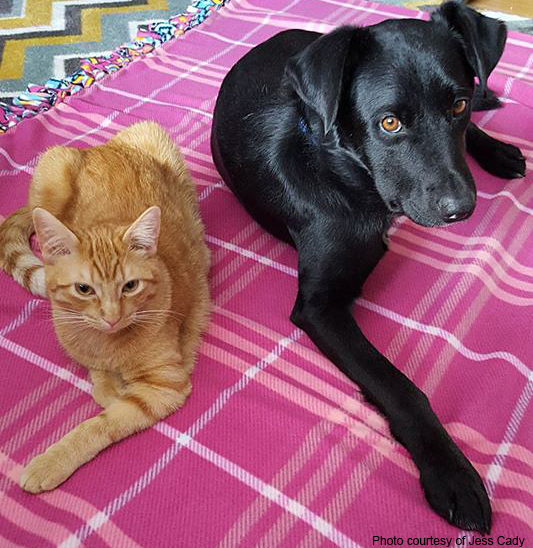Dogs are social creatures, just like humans. And so are cats, by the way. But, of course, that doesn’t mean that everyone gets along with everyone else, same species or not. Scenarios where individuals are more or less forced to live together and don’t always have a say in who they share with are common. Starting with the family you grow up in (and hopefully it worked out for you!), you may have moved on to share with friends or fellow students, and maybe even later in life, because you couldn’t afford a place on your own. Age or disability may also force you to live in a home where sharing with others is unavoidable.
There are situations where living together simply doesn’t work out. There could be a clash of personalities or incompatible lifestyles. There could be constant fighting or even an abusive relationship. If you are not able to change your situation and feel trapped in a social network, you are likely to suffer mentally, emotionally and, quite possibly, physically. I assume this may be a major reason that people disappear. And, it is mind-boggling just how many people go missing without a trace every year.
Now spare a thought for all those animals that we add to our homes. Not only do they not have a choice if they want to live with us in the first place, they also have no say every time a new family member is added. How do they cope? Well, not always very well. Some animals do wander off in search for a better life – mostly cats who have better survival chances than dogs – but most animals are unable to vote with their feet. They are either physically trapped or their dependency on us is so great that escape is not an option. And, just like humans, they get stressed, depressed and anxious if they have little control over their lives.
Trying to tick all the important boxes before adding someone to your family is ideal, but in reality neither our decision-making nor life itself are always ideal. Not even close. So, if you already are in a challenging situation, here are some things you can do to create a more harmonious household.
Everyone needs to feel safe
If you live in a mixed species household, consider the natural relationship between the animals (predator – prey?) and have safety measures in place. The risk of your dog preying on your cat or guinea pig may be low, if they have grown up together, but it is never zero. Leaving them alone together without supervision can end in disaster. So is leaving large dogs with tiny dogs or animals that don’t know each other well or have a history of serious fighting.
Of course, who is scared of who isn’t always clear-cut. If your dog tip-toes around the house because they are constantly vigilant of being ambushed by your cats, it may make for ‘funny’ YouTube videos but it sure is a hellish life for your dog.
If any of your animals is afraid of others in your household – and that includes you, your children and anyone who comes to your house – things need to change. For example, change how you manage your animals, think about how your own actions affect your animals’ behaviour and avoid anything that could scare your animals. Don’t be hesitant to engage a qualified positive reinforcement animal trainer or veterinary behaviourist to set you on the right track.
Everyone needs their own space
Personal space is not just a human need. Opportunities to retreat and not be bothered by other members of the family – human or other – are essential for everyone. For cats this means high places where dogs and kids can’t reach. For dogs this may be a crate, a playpen or a cosy bed under a desk that is off limits to everyone else. This is especially important, if the dog or cat is shy or anxious. Closely supervise any human member of the household who is not old enough or able to understand that animals are not toys.
Having separate feeding, resting and toileting stations for your animals is important. For example, don’t expect your three cats to share one litter tray, keep your puppy away from your senior who is desperately trying to have an afternoon nap and feed dogs separately who have a history of being a little too protective of their food. Stressful situations cause friction and, if repeated over and over, can escalate and make one or more of your animals decidedly unhappy and even sick.
Everyone needs to be listened to
Animals living with humans have one very significant problem: They can’t tell us how they feel or what they want. Understanding another species – which mostly means understanding what their body language and behaviour might tell us – is a science and needs to be learned from qualified animal behaviour experts. So, in order to understand your animal better, stick to sources that rely on actual animal behaviour research. Avoid following advice you hear on TV, social media or from anyone who thinks they have all the answers but no scientific data to back it up.
If you are able to recognise your animals’ emotions and moods, you can take immediate action if things are not well. Rather than being reactive to ‘unacceptable’ behaviour and potentially making a situation worse, your knowledge and understanding will turn you into a skilled planner, coordinator, negotiator, protector and friend.
To sum it up, if a multi-animal household is to have any chance of success, each individual must feel safe and have the right to express themselves in a species-typical way. Sometimes this means you have to get creative with how you provide suitable outlets for your animals’ favourite activities. You are, after all, a zoo keeper.
 Copyright secured by Digiprove © 2017 Sylvie Martin
Copyright secured by Digiprove © 2017 Sylvie Martin 
